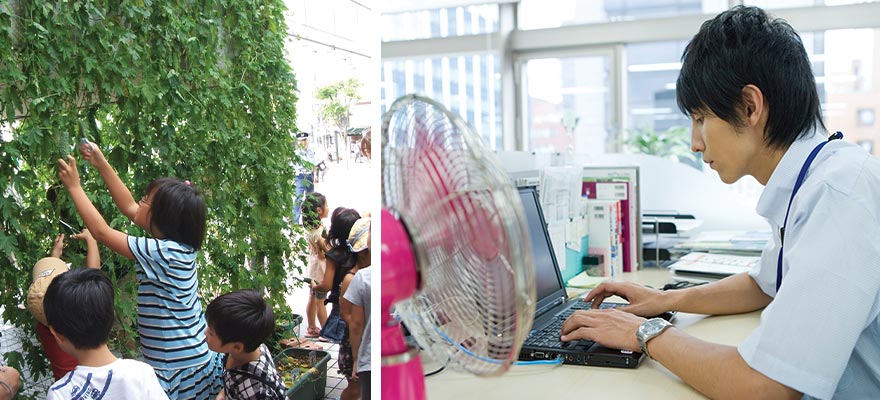Home > Highlighting JAPAN >Highlighting Japan July 2014>Summer in Japan
Highlighting JAPAN
Summer in Japan
Cool Biz
Cool Tips to Get Through the Hot Summer

Summers in Japan are very hot and muggy, and a good part of traditional culture was born from the longing to stay cool through everyday ingenuities. Along with yukata, uchiwa fans, furin (wind bells) and kakigori (shaved ice desserts), a recent addition to the typical sights of a Japanese summer is 'Cool Biz,' a campaign intended to tackle climate change by saving energy in the workplace.
Not very long ago, men in Japan were convinced that they had to stay formal in business venues even in the summer, which meant walking around outside under the flaming sun in suits and ties. Meanwhile, inside the office, air conditioners would be turned on full blast, so women had to equip themselves with woolen sweaters and lap blankets in midsummer. Nowadays, however, freed from jackets and ties, wearing short-sleeved shirts, and with air conditioners set at 28 degrees Celsius, even men can get through the day comfortably. With their suits cast aside, they look calm, cool and collected.
What is the story behind the 'Cool Biz' movement taking effect so quickly and so widely? "Shared concerns about the urgency of the global environment could have encouraged people to take up Cool Biz," suggests Nanae Fujimoto, chief administrator of the Lifestyle Policy Office in the Climate Change Policy Division of the Ministry of the Environment's Global Environment Bureau.
In 2005 the Kyoto Protocol went into force, and international society reaffirmed its commitment to combatting climate change. Public awareness climbed in Japan. Business and government leaders took the lead in changing their outfits. It didn't take long for the rest of the country to follow suit.
This new trend in Japanese business attire spurred a wave of innovation by the apparel industry. New materials with various features including moisture and sweat absorption, quick drying and controlled ventilation were developed, and 'Cool Biz' sections in retail stores thrived. Trains offered "mildly cooled cars" for passengers who wished to avoid the standard air-conditioned cars. Such reactions highlight the delicate receptiveness and responsiveness of the hearts and technologies of Japan, says Fujimoto.
Other innovations come from everyday life. Raising morning glories in the summer, for example, has been a common practice in Japan for ages. From around 2011, however, various plants grown along houses and buildings came to be known as 'green curtains.' Growing green vines at the window such as goya (bitter melons) or cucumbers, their tendrils extending as they flourish, these curtains block the strong sunlight and provide nutrition, a perfect example of killing two birds with one stone. According to Fujimoto, this originally began as an experiment by urban engineering researchers and others in a few areas. The Ministry of the Environment subsequently promoted 'green curtains' as one example of ways to cope with power shortages. Having benefits to the planet as well as to one's wallet and health, what was once a unique regional practice has now become a popular pastime.
Fujimoto stresses that, "our role is merely to help people realize what they can do." Overachieving Japan's international obligation to reduce greenhouse gas emissions by 6 percent from 1990 levels, the Ministry of the Environment launched its next campaign called 'Fun to share.' Just like the 'green curtain' example, this campaign calls on individuals to share whatever they're doing that makes use of everyday ingenuities or the latest technologies?in short, anything useful that is climate-friendly. Seeing that changing individual lifestyles leads to saving the global environment is a realization that is already a step in the right direction.
Japan's Cool Biz initiative received praise from Rajendra Pachauri, chairperson of the Intergovernmental Panel on Climate Change, during a speech at the Global Environmental Action International Conference 2007. He stated: "One of the major findings that we have . . . is the importance of lifestyle changes. . . . There has to be a change in human behavior, and I think in this regard, I must say that Japan is setting an outstanding example." Subsequently in 2008, temperature settings on air conditioners in the United Nations were raised under the rubric 'Cool UN.'
Companies and researchers are not the only source of innovations. It is the awareness of each and every one of us that ultimately will help save the Earth.
© 2009 Cabinet Office, Government of Japan






